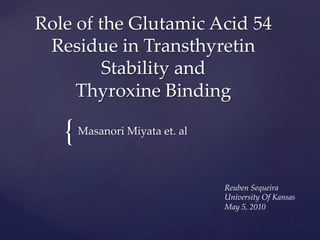
Senior Seminar Presentation
- 1. { Role of the Glutamic Acid 54 Residue in Transthyretin Stability and Thyroxine Binding Masanori Miyata et. al Reuben Sequeira University Of Kansas May 5, 2010
- 2. Presentation Overview o Background on Transthyretin • Mutations causing Amyloidosis • Significance in disease study o Purpose of this research o Methods and techniques used • X-‐‑ray crystallography • 3D transthyretin models o Results o Discussion • Take home message from this research
- 3. Familial Amyloid Neuropathy o Onset of disease during ages 20 – 40 o Hereditary and autosomal dominant disease→ need only one mutation in one gene to acquire FAP o Disease observed worldwide but first detected in Portugal. o E54K mutation prevalent in cases within Japan and E54G common in the UK (1) o Amyloid deposits in various tissues results in multiple neuropathy
- 4. Transthyretin a.k.a TTR o Transports thyroxine and retinol o 55kDa homotetramer (127 residue monomers). Gene located on chromosome 18 o Synthesized in the liver o Maintains normal level of retinol, Vitamin A binding protein and thyroid hormone in blood plasma
- 5. Essence of this Research o By studying the E54G and E54K mutations and their TTR products, a comparison can be made with wt TTR and hence the importance of the Glu54 residue in TTR.
- 6. Methods and Approach Expression and Purification • E54G/E54K plasmids prepared using site-‐‑directed mutagenesis • Anion-‐‑exchange chromatography and reverse-‐‑phase HPLC CD (Circular dichroism) TTR stability assay • Incubated in 0-‐‑8M Urea at 25˚C for 96h Tetramer-‐‑monomer transition Assay • 100mM KCl induced at pH 3.5-‐‑7 Another TTR stability assay based on T4 binding Thioflavin T binding assay after incubation with KCl And…
- 7. …X-‐‑Ray Crystallography and Structure Determination o Crystal formation 10days after incubation with 200 mM citrate buffer and 3 M ammonium sulfate pH 5.3 • Steps in crystallographic study o Crystallization o X-‐‑ray diffraction pahern and raw data collection o Refinement of data o Compute electron density map o Build and refine 3D model
- 9. Results and Findings • wt TTR and E54G TTR have similar fractions of monomers/tetramers at indicated pH • E54K TTR has significantly more monomer formation than wt/E54G • stability based on urea denaturation→ wild-‐‑type TTR (Cm=3.54)>E54G (Cm=3.05)>E54K (Cm=2.58)
- 10. • Different distances between the two 54 residues in the dimer-‐‑ dimer interface • Distinct surface electrostatic potential around residue 54
- 11. • Glu54 forms a hydrogen bond with Lys15 and His56, stabilizing positive charge of Lys15 • In E54G, a water molecule mediates interaction between S52 and His56 • In E54K, H-‐‑bond is broken and K15/K54 causes repulsion
- 12. Amyloid fibril formation and stability of tetramer
- 13. • 54 is at the opening of the T4 binding pocket • E54G and E54K had the highest and lowest T4 association and dissociation rates respectively.
- 14. Tetramer stability and Amyloid fibril formation in the presence of T4 • wt TTR : 12.18 monomer ratio • monomer level of E54G TTR was 34.43 • monomer level of E54K TTR was 92.18
- 15. What do these findings tell us?? • wild-‐‑type and Glu54 TTR variants have significantly different side chain interactions and surface electrostatic potential around residue 54 • Glu54 modulates the positive charge of Lys15 and hence minimizes the repulsion between K15 of the two monomers which stabilizes the tetramer • The change of residue 54 in the TTR variants affects T4 binding and hence decreased T4 binding increases tetramer instability
- 16. Closing thoughts • Various FAP associated mutations lead to TTR tetramer instability and hence favoring amyloidogenises • Could another residue besides Glu54 (wt) stabilize the tetramer? • T4 binding studies using these residues located in the pocket, show that binding affinity is important to tetramer stability • Small molecules are in the process of being developed that can appropriately bind to this pocket with high affinity and decrease fibril formation
- 17. Acknowledgements I would like to thank HaiYan Zhao and Dr. Tang for crystallography expertise. I would also like to thank Shyam Mehta for giving me useful tips for this presentation.
- 18. References • Miyata et. al. (2010) Role of the Glutamic Acid 54 Residue in Transthyretin Stability and Thyroxine Binding. Biochemistry 2010, 49, 114–123. • Ando, Y., Araki, S., and Ando, M. (1993) Transthyretin and familial amyloidotic polyneuropathy. Intern. Med. 32, 920–922. • Miroy, G. J., Lai, Z., Lashuel, H. A., Peterson, S. A., Strang, C., and Kelly, J. W. (1996) Inhibiting transthyretin amyloid fibril formation via protein stabilization. Proc. Natl. Acad. Sci. U.S.A. 93, 15051–15056. • Miroy, G. J., Lai, Z., Lashuel, H. A., Peterson, S. A., Strang, C., and Kelly, J. W. (1996) Inhibiting transthyretin amyloid fibril formation via protein stabilization. Proc. Natl. Acad. Sci. U.S.A. 93, 15051–15056. • <hhp://www.iupui.edu/~amyloid/information.htm> • <hhp://www.ncbi.nlm.nih.gov/bookshelf/br.fcgi?book=gene&part=tfap> • <hhp://ghr.nlm.nih.gov/condition=transthyretinamyloidosis>
- 19. { Questions and Comments? Thank You and Happy Cinqo de Mayo!!
